|
On The Moon in 3D
This image can be seen in stereo 3D with the special glasses you can order from near
the end of the of the page titled, "Our First Steps to MARS," on this web site.
Astronaut Alan Bean on the Moon in 1969
This 3D picture was taken by Astronaut Charles Conrad and shows you work in progress on the
Moon, from the "Apollo 12" flight of exploration on November of 1969. The area is in what is known as the Oceanus Procellarum,
which is a lava plain that is considered to be about 3.1 billion years old.
In July, 2004
Our "Cassini" space explorer
sent back this fantastic image of the Rings of Saturn
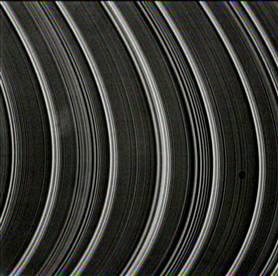
This picture was taken from NASA TV. It shows "density waves" caused by the gravitational influence
of Saturn's moons. This fine close-up shows us details that have never before been seen.
See below, for a spectacular artist's conception of the
moon probe exploration.
The Probe To Saturn's moon, "Titan."

Here a NASA artist shows us the "Huygens" probe dropping from the "Cassini" spacecraft to the
mysterious, shrouded surface of the "Titan" moon.
The atmosphere is mostly nitrogen, with thick clouds of hydrocarbons, very
much like "smog" and the atmospheric pressure is approx. one and a half times that of our Earth.
The schedule for this probe of the moon is in December of 2004.
The Search for Life
With the Saturn Probe
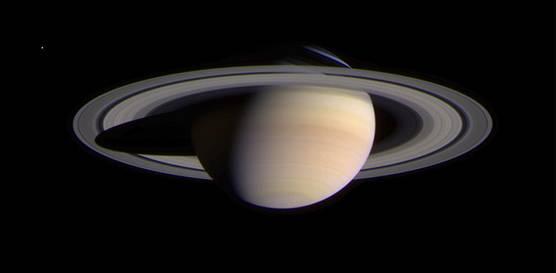
The image above is from the "Cassini" spacecraft and was taken and transmitted as the craft was making
its final approach to the planet Saturn at the end of February, 2004. The picture was taken at 43.1 million miles from the
planet.
You will notice that the spokelike markings, that were observed
and filmed during the approach of the Voyager probe 23 years ago, are no longer visible. No one has any idea why this has
happened.
The Saturn
system survey start date is July 1, 2004. A flyby and close examination of "Titan," Saturn's largest moon, is scheduled a
few days later. This is a preliminary activity to a scheduled probe into the "Titan" atmosphere on Jan. 14, 2005.
The "Cassini" spacecraft will release its "Huygens" probe and it will descend
through the atmosphere of "Titan" where it may encounter a scene possibly not unlike the one depicted above by a project artist
of the NASA/ESA/ISA endeavor.
There are good reasons why a probe to "Titan" makes sense. This largest moon
of Saturn is flexed by the gravitational forces of Saturn to the extent that it has notably heated up. It also has an atmospheric
pressure about that of Earth. It is also believed to have seas in liquid form.
The chemistry is considered to be somewhat different but it is very possible
that some form of aquatic life may have developed. Even on Earth we have discovered primitive life forms living off of chemical
compounds that would be fatal to humans.
So, the chance of finding life there is not at all out of the question,
but it is not something that we actually expect to find. We will just have to keep exploring and learn what we can.
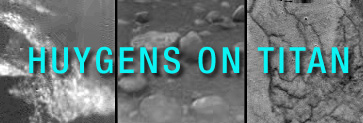
The European Space Agency "Huygens" probe lands on Titan on Friday, January 14, 2005
Titan, one of the moons
of Saturn, is the largest moon in our solar system and has an atmosphere that is believed to be 50 percent denser than our
own planet, Earth. It is an atmosphere that is rich in nitrogen, methane and other "exotic" gasses.
Many scientists believe that it is an atmosphere very much like that of the
Earth several billion years ago, at a time when life may have begun on our planet.
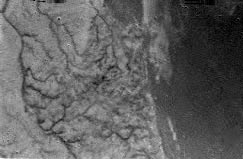
An early, unprocessed image of the surface of Titan, as taken while the probe was descending. The
picture was taken using the Descent Imager Spectral Radiometer.
Early pictures suggest the strong possibility of drainage channels and a
black & white shoreline can also be seen in some of the images. And, in another image, taken from the surface, rounded-off
blocks of what looks like ice embedded in other material, seems to go on and on to the horizon.
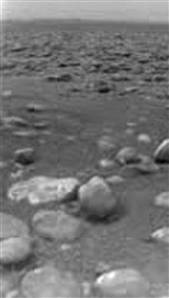
From the surface of Titan.
With Additional Processing, We Now Have The First Color Image On The Surface
of Titan
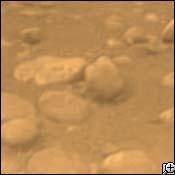
What the scientists first believed might be ice blocks are now better understood to
be the size of pebbles. It has also been found that the surface of Titan is actually somewhat darker than they had expected
it to be. And, it seems to be a mixture of water and hydrocarbon ice. You can also see evidence of what seems to be erosion.
With Still Further Image Processing,
We Can Show You The Following...
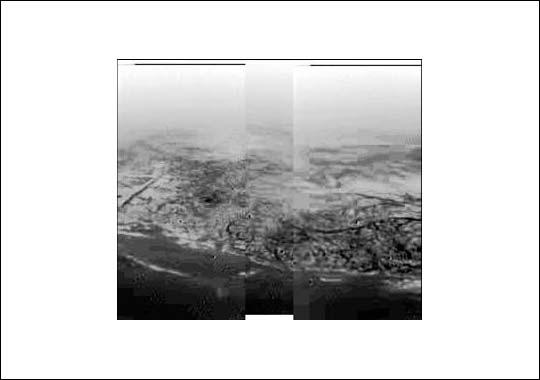
This picture is a composite of images taken during the descent, from approx. 5 miles altitude.
These are important images of a truly historic moment in human history. We
are honored to be able to share these with you at this time.
Another historic moment. The "NEAR" space probe landing on the
Eros asteroid.
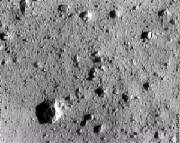
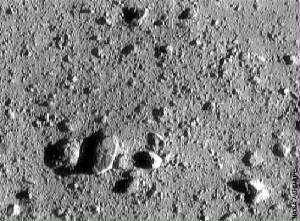
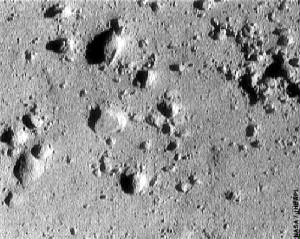
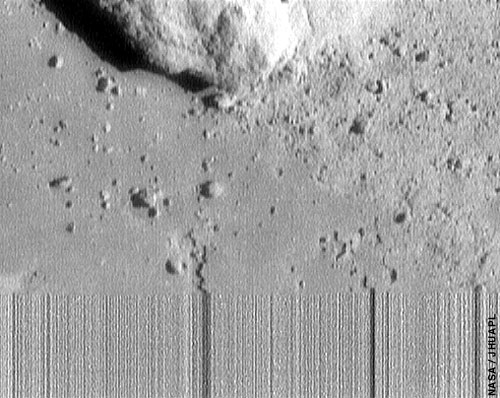
|

